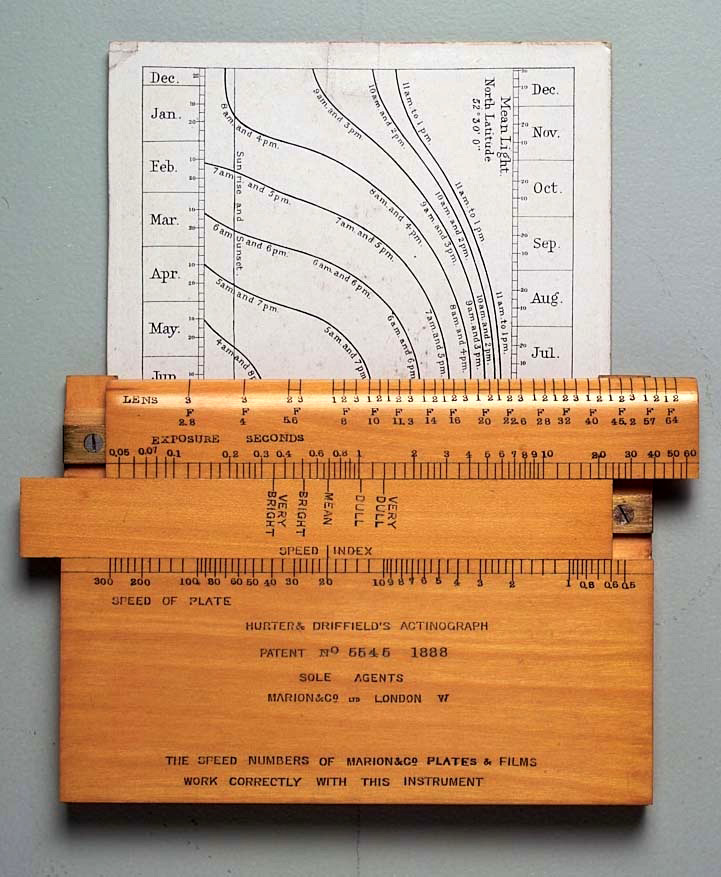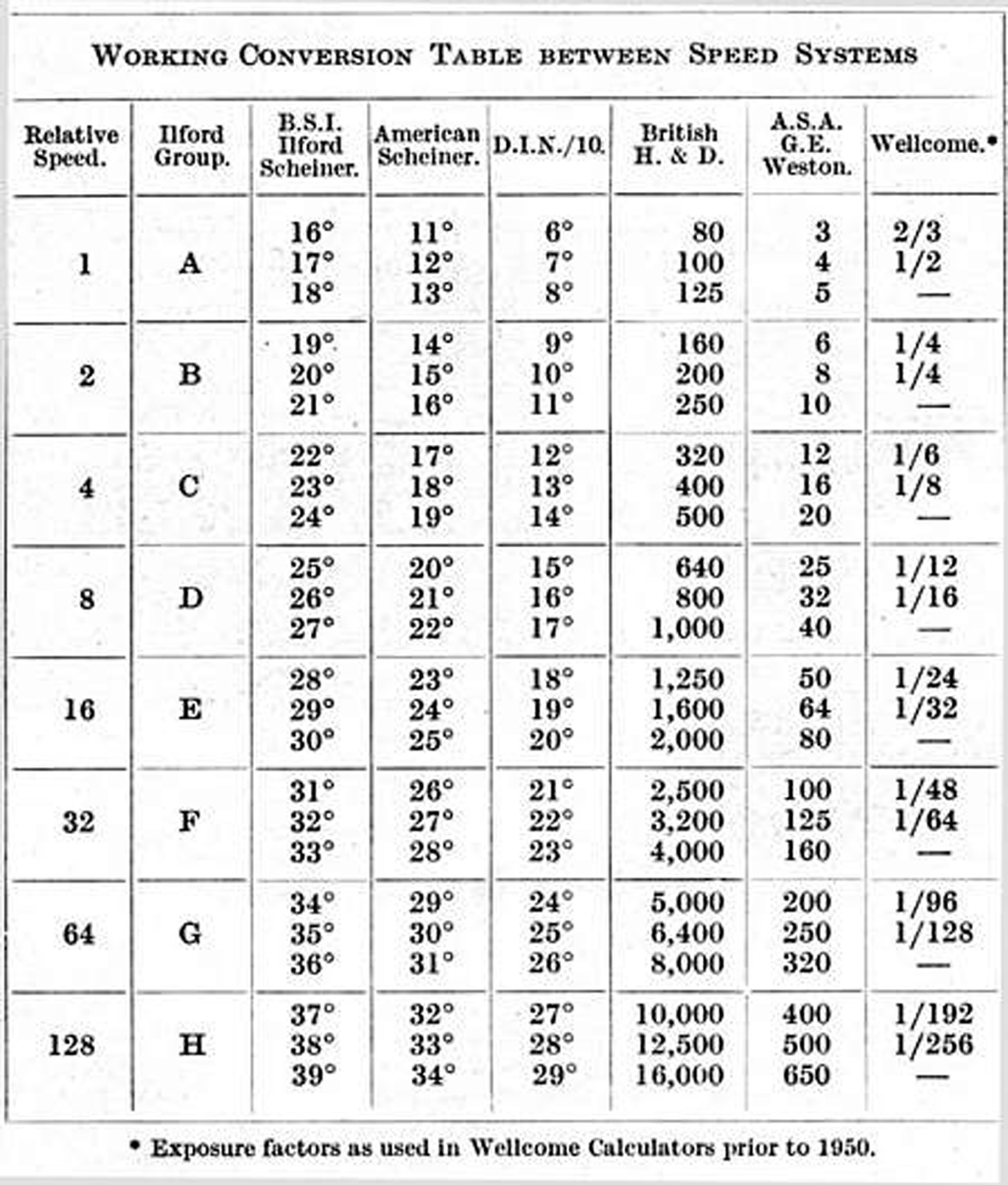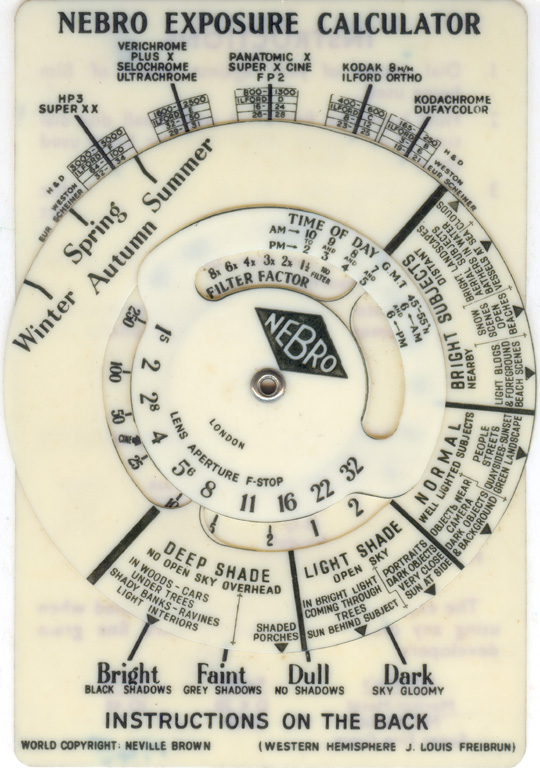

PHOTOGRAPHIC EXPOSURE CALCULATION - A HISTORY
|
The earliest photographic emulsions, the Fox-Talbot Calotype Fox-Talbot Calotype & the Daguerreotype Daguerreotype, were so insensitive to daylight (blue thru' UVA), that exposure times were a matter of guestimation born from experience. Exposures ran to several minutes even in high summer sunlight. The first photographic exposures tables were published by C.F. Albanus in 1844 and journals and manuals would often include such tables as a guide to exposure.. 

The solar eclipse of July 28, 1851 was the first correctly exposed photograph of a solar eclipse, using the daguerreotype process.The earliest commercial photographic exposure meter was Claudet's Photographometer, 1848, described in "The History And Practice Of The Art Of Photography; Or The Production Of Pictures Through The Agency Of Light" by Henry H. Snelling, Published BY G. P. Putnam, 155 Broadway, 1849. History And Practice Of The Art Of Photography Frederick Scott Archer's invention of the Collodion process in 1851 Collodion & its subsequent improvement by Bolton & Sayce in 1864 Bolton & Sayce led to a marked increase in sensitivity, yet exposures in full sunlight still required several seconds, and because the collodion & silver salts emulsion was prepared by hand for each batch of glass plates, the speed of the batches varied, leaving the photographer the chore of determining the exposure based on personal experience. Formal measurements were first conducted and published by Bunsen and Roscoe in 1858 which connected sunlight with the position of the sun to time of day and year. The invention of the gelatin dry plate silver bromide process in 1871 by Richard Leach Maddox, Richard Leach Maddox and the subsequent commercial sale of hard emulsion dry plates by Charles Bennett in 1878 Charles Bennett, led to a further increase in sensitivity, and a need for a means of measuring reflected light in order to determine the exposure time. The Bing graduated wedge actinometer, invented in 1866-68 provided a numerical value for light, as compared to a relative comparison of plate sensitivities provided by Claudet's Photographometer and Brice's 1876 patented instrument that tested the developing chemicals & light conditions by making test strip exposures. The earliest calculator introduced by Hurter & Driffield in 1888 was the result of their extensive work on emulsion sensitometry Hurter & Driffield The "Actinograph" was a slide rule calculator designed for use in England, sold by Marion & Co. from 1892. 


The late 1880's saw the invention by George Eastman of nitro-cellulose roll-film and the Kodak box camera which heralded the advent of popular photography. George Eastman Kodak Exposure times were fixed, the box camera being supplied pre-loaded. Exposures were made outdoors in good light, and the camera returned to Kodak. "You press the button, we do the rest". 

http://www.geh.org/fm/toronto/htmlsrc/mE13100003_ful.html#topofimageKodak introduced their folding pocket camera in 1898. It too had a fixed shutter speed. When their No.1 Autographic Junior folding camera was introduced in 1915, because it had a leaf shutter with variable speeds, exposure calculators came into general usage although Burroughs-Wellcome had incorporated cardboard dial calculators into their Photographic Diary from 1900. 

http://images.wellcome.ac.uk/ixbin/hixclient.exe?MIROPAC=L0038523 The No.1 Autographic KODAK, Junior 1815 advertisement No.1a AUTOGRAPHIC KODAK JR. folding camera No.1 SERIES III AUTOGRAPHIC KODAK Throughout the first half of the C20th exposure calculators were the vogue. . Direct means of measuring ambient light comprised Actinometers, manufactured by Green & Fčidge (1884); Watkins (1890); Wynne (1893) & Bee (1902), and Extinction meters, manufactured by Decoudon (1897); Heyde (1904); James; Minofot; Dremophot (1926 & 1931). Photoelectric photographic exposure meters became portable by the early 1930's pioneered by Weston, GEC, AVO, & L.M.T. Actinometers, Extinction, & Photoelectric light meters, are all types of light measuring devices. There purpose is to provide a qualifiable or quantifiable measure of luminous intensity of actinic radiation. Slide rule type exposure calculators rely on the photographer to estimate the scene brightness. Calculators were provided with lighting subject factor tables; usually determined for a specific and narrow range of latitudes, and film speed factors, either in recognised rating systems or a rating system defined by the calculator's manufacturer. Because exposure calculators were very much cheaper than Actinometers, Extinction & Photoelectric light meters, they entered into common usage in the early C20th and remained so until the 1960's.. It is possible by comparing exposure indices and emulsion speed rating systems employed in these calculators to make comparisons between the sensitivities of photographic films and earlier dry and wet plates. This I have done and the results have been compiled into an Appleworks spreadsheet, and a page view 1Mb pdf plate_film_sensor_ratings. Here are a few examples from my collection chosen as representative of the type of exposure calculators in use from about 1930 thru' 1960.  PHOTAX ADDEX EXTINCTION METER 1939


NEBRO VISUAL EXTINCTION METER 1949
The Amateur Photographer magazine Exposure Calculator c1950

Cappelli - Milano Fotometro c 1930

Ensign Posometer "dial" calculator c1930

Concentric Indicator Laboratories Fotogram c1949

Nebro exposure calculator manufactured by Neville Brown & Co. Ltd. c1949.

Johnson's Standard exposure "dial" calculator c1955 (intro 1945)

Kodak exposure calculator Model II - undated, c1960
How do exposure calculators work? Exposure Value Chart
iii) The sensitivity of the photographic emulsion or the equivalent sensor sensitivity is nowadays expressed as an ISO value. The ISO scale is based on the old ASA scale and is arithmetic, a doubling of the ISO number corresponds to a doubling in the emulsion or sensor sensitivity. (A CCD or CMOS sensor has a base sensitivity, increasing the ISO rating does not in reality increase the sensor's sensitivity, it equates to an increase in the readout A/D amplifier gain setting). So how is the calculation made?The exposure duration is inversely proportional to the area of the lens, emulsion speed and subject brightness. If we call the exposure duration "t" for time in seconds; the lens area "A", the emulsion or sensor speed "S" and the subject brightness "B"; we have: A x S x B = 1/t "A" can be expressed in terms of the f/#, but because the f/# is based on the square root of the lens area, if we substitute f/# for "A" we must square it, and because f/# is a reciprocal: A = 1/(f/#)2 hence: t = (f/#)2/S x B We know what units "S" is expressed in - ISO speed numbers, but what about "B", what units is it expressed in? The brightness value "B" is determined from the exposure value (Ev). B = (2^Ev)/ &Pi An article based on this method, applied to astrophotography exposure time calculation was published by Richard Levy in Sky & Telescope's "Observer's Page" July 1962. (When Sky & Telescope was a subscription only magazine dedicated to the serious amateur astronomer and not today's dumbed down off-the-shelf hobby mag. It is a disgrace that none of S&T has been digitized and archived, and that neither NASA's ADS service or Google or Biblioteque have been given permission to digitize the archive. So I reproduce the pages here.) S&TJUL1962_p30 S&TJUL1962_p31 Is there a simpler way?Yes, its called the APEX or "Additive Photographic EXposure" system APEX developed in 1960. Although, in general, it did not catch on with photographers, it did prove a boon to astrophotographers. We can rewrite the algebraic equation in terms of base 2 logarithms thus: from: A x S x B = 1/t is obtained: lg.A + lg.S + lg.B = -lg.t The APEX system defined pairs of these terms in terms of exposure value Ev from which the APEX equation follows: Ev = Av + Tv = Bv + Sv & putting: Av = 2lg.f/# Tv = -lg.t Bv = lg.B.&Pi (B rationalised into foot-lamberts) Sv = lg(ISO/&Pi) is obtained: Ev = 2lg.f/#+ -lg.t = lg.B.&Pi + lg(ISO/&Pi) This may not at first glance appear simpler, but it is, because using the APEX system you can compile a simple additive table or draw nomograms nomograms or construct slide rules slide rules. For example the LORD ASTROPHOTOGRAPHY EXPOSURE TIME NOMOGRAM first published in the JBAA,89,3pp273-278 April 1979. <p273><p274-275><p276-277><p278> (Again it is typical of the BAA, an organisation with a considerable balance sheet invested here there and everywhere, that they cannot find the wherewithall to digitize their journal archive, although some of it is available from NASA's ADS service)
LORD ASTROPHOTOGRAPHY EXPOSURE TIME NOMOGRAM c1979and the "Astrophotography Exposure Calculator" designed by Glen LeDrew and sold by The Starry Room. 
The APEX Ev table follows from the base 2 log scale values: 
NB When B is expressed in candles/sq.ft Ev=0 corresponds to t=1s; f/# = 1; ISO = &PiA book based on the base 2 log APEX system was published in 1985 by Willmann-Bell Inc. "Astrophotography" by Barry Gordon, featuring the fx system of exposure determination. Astrophotography How do I use the APEX system to calculate an exposure time?Suppose you are photographing the First/Last Quarter Moon, high in a clear night sky, with an f/7 telescope, using either ISO100 film or a DSLR set to ISO100. From the APEX equation: Ev = Av + Tv = Bv + Sv and from the APEX table we obtain the following values by reading across to the Ev column from the f/#; ISO & Brightness columns: f/7 corresponds to Av = 5.7 B = 40 corresponds to Bv = 7.0 (B=40 is the brightness value of the First/Last Quarter Moon) ISO100 corresponds to Sv = 5.0 from which: Tv = Bv + Sv - Av = 7.0 + 5.0 - 5.7 = 6.3 & Tv = 6.3 corresponds to t = 1/81 secs & you then select the closest shutter speed available; either 1/50s, 1/60s, 1/100s or 1/125s. Maybe your DSLR allows you to select 1/80s, if so, so much the better. Exposure times should be bracketed ▒1 stop at least. If the sky is hazy, or the Moon low, bracket from -1 stop to + 2 stops. POSTSCRIPT Chris Lord This page was created by SimpleText2Html 1.0.2 on 22-Feb-2010 Top of Page Return to Home Page |